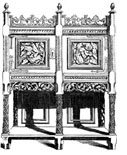
The Four Marks of a Vocation
THE VOCATIONS DROUGHT THAT NEED NOT BE
Father James Gould is best known for being one of the most successful vocations directors in the U.S. since the Second Vatican Council (1962-1965). For 15 years, from 1985 until 2000, he was charged primarily with promoting and fostering vocations to the priesthood for the Diocese of Arlington under Bishop John Keating. During that time, the relatively small diocese of 65 parishes in northern Virginia produced an average of eight new priests each year. By the year 2000 the average age of priests in Arlington was 42, twenty years below the national average! What makes these statistics even more impressive is that this was accomplished during a time known throughout much of the Western world as a vocations drought.
The formula for his success? Says Fr. Gould: “Unswerving allegiance to the Pope and magisterial teaching; perpetual adoration of the Blessed Sacrament in parishes, with an emphasis on praying for vocations; and the strong effort by a significant number of diocesan priests who extend themselves to help young men remain open to the Lord’s will in their lives.”
Some vocations offices over the past three or four decades have tried to implement very complicated programs in order to attract men to the priesthood. But not in the Diocese of Arlington under Fr. Gould’s watch. There was no “vocations team” involved with the Diocese’s Office of Vocations while he was director. “Teams tend to be a bureaucratic burden,” he explains, “with all sorts of agendas that cost great amounts of money. Simplicity, as much as generosity, is a virtue for vocations directors.”
Rather than spending his time with “paper projects” that always seem a bit disconnected from reality, Fr. Gould preferred to travel to parishes to preach about priestly vocations at Sunday Masses, as well as to groups at schools, colleges, Scout retreats, Knights of Columbus councils, even at military bases. This, he says, gave him a chance to look into the eyes of parishioners and talk directly to them about fostering and promoting vocations to the priesthood.
The Diocese of Arlington had very concrete goals regarding vocations during his tenure. Each year, he explains, “we looked for ten new priesthood candidates, rather than ten percent increases. ‘Ten men’ is a concrete goal and every priest plays a part in achieving this goal.” Only in a couple of years during his time as Vocations Director did the Diocese fall short of achieving that goal. But one year Arlington had 22 new men entering seminary — more than enough to make up for the “shortage” in other years. Consequently, after such remarkable success during those 15 years, the Diocese of Arlington has no “priest shortage” as other American dioceses increasingly do.
You May Also Enjoy
President Bush is worried that Vladimir Putin is heading toward an authoritarian regime: Moscow has banned a 'Gay Pride' parade -- very un-democratic.
The extraordinary form has a depth of imagery that the post-Vatican II revisers of the Mass simply eschewed, especially as regards the eucharistic sacrifice.
In Italy there was a culture of Catholicism, of an old Catholic people -- unassuming, tolerant, and devout in a way that only people who know who they are can be.

